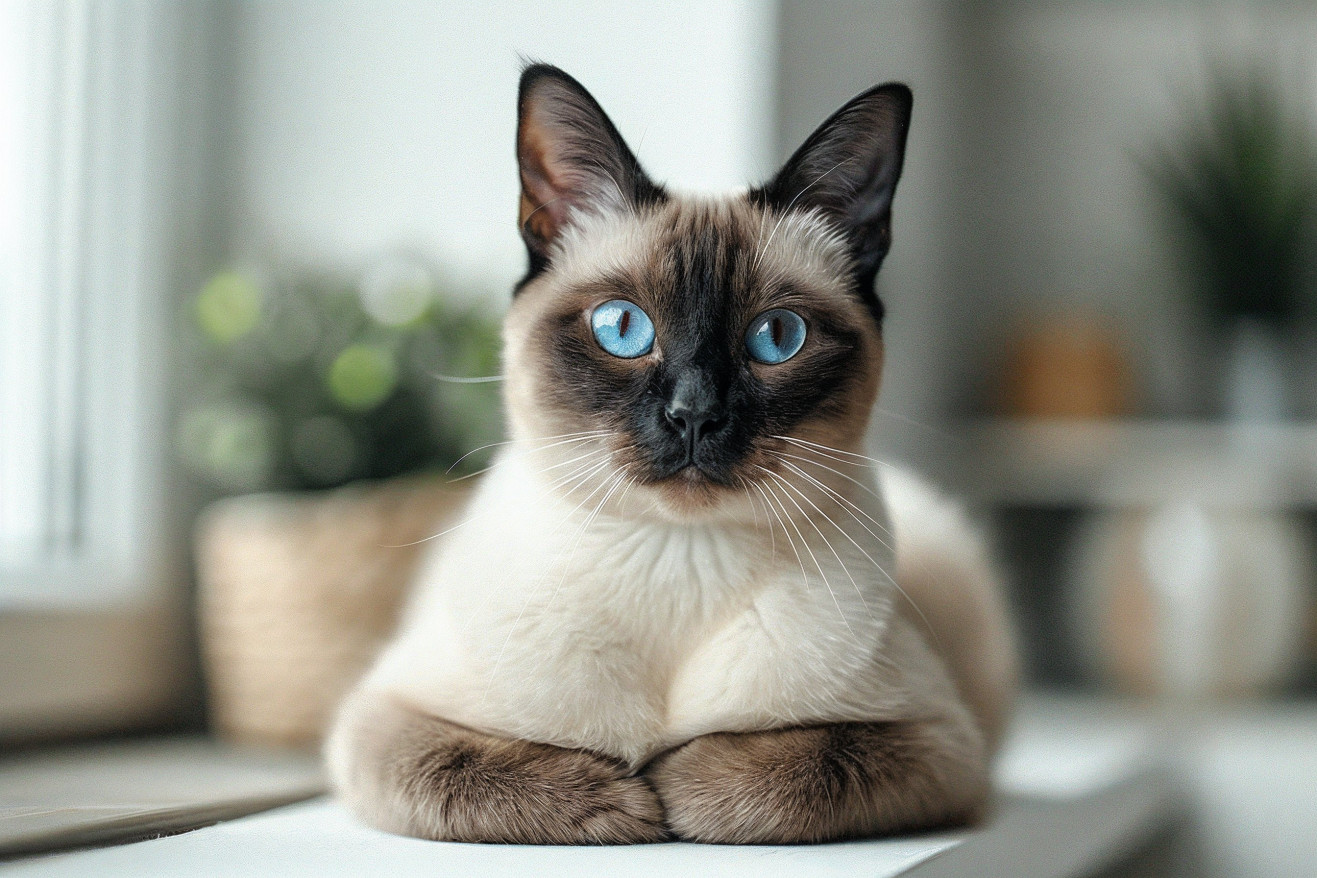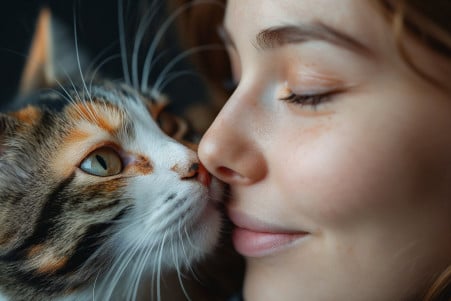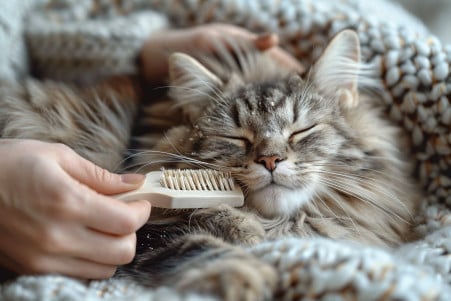Why Is My Cat Overgrooming? Reasons and Remedies
5 June 2024 • Updated 3 June 2024

If your cat is overgrooming and losing hair, there are many potential reasons, including stress, allergies, underlying medical conditions, or compulsive disorders. As a result, it's important to figure out the cause and treat it accordingly. If your cat is overgrooming to the point of creating bald patches, there are many potential causes, including stressors like moving or adding a new family member, seasonal allergies and dry skin, gastrointestinal issues, hyperthyroidism, or even psychological issues like anxiety or obsessive-compulsive disorder.
Below, we'll explore some of the potential causes of this concerning behavior based on veterinary studies. Understanding the biological, environmental, and psychological causes of overgrooming will help us determine the best solutions. With a little help from scientific research that looks at things from the cat's point of view, we can hopefully help your cat feel better.
Why is my cat pulling her hair out?
Medical Reasons for Overgrooming
One of the most common causes of overgrooming in cats is skin irritation due to an underlying medical issue. According to Vetstreet, cats that are itchy are likely to scratch, lick, or pull out hair. While the cause of the itchiness can be difficult to determine, it often begins with a physical exam to rule out external parasites like fleas, mites or lice, which can cause overgrooming. Bacterial or fungal skin infections can also cause itchy, inflamed skin according to Vet Focus.
Allergies are another common cause. According to PetMD, environmental allergens like dust, pollen and mold, and food allergies can cause cats to lick, bite and scratch excessively, leading to hair loss and skin irritation. In some cases, cats may overgroom areas of the body that are painful, such as the belly in cats with cystitis or the joints in cats with arthritis.
In addition, certain medical conditions such as hyperthyroidism or gastrointestinal issues can cause overgrooming. To find and treat the cause, Catster stresses the importance of a veterinary exam and diagnostic tests like skin cytology or allergy testing. Finding and treating the medical cause is the best way to stop the overgrooming.
Stress and Behavioral Causes of Overgrooming
If there is no medical reason for the overgrooming, it could be due to a psychological condition known as Feline Psychogenic Alopecia, which is caused by stress or psychological conflict. According to Cats.com, this is a type of repetitive, compulsive behavior that results in the cat overgrooming and pulling out their own hair and is often caused by an underlying stressor.
FirstVet explains that stress and anxiety caused by changes in the environment, a disruption in the cat’s routine, or the addition of new family members or pets can cause this type of compulsive overgrooming. Stress-related overgrooming is more common in certain breeds, such as Siamese, and in multi-cat households with indoor cats, according to AKC Pet Insurance.
It’s important to manage this condition by identifying and managing the underlying causes of stress, as well as providing environmental enrichment and possibly behavioral medication. According to Zoetis Petcare, anything that changes, moves, or is added to a cat’s environment or routine can be a potential trigger for stress-related overgrooming.
How Excessive Grooming Is Treated and Prevented
If a medical cause for the excessive grooming is found, such as parasites, allergies, or skin infections, the vet will likely prescribe treatment such as parasite control, antibiotics, or allergy management to treat the root cause. The MSPCA explains that while the skin is healing and the itchiness is being treated, an Elizabethan collar may be necessary to prevent licking.
For stress-induced overgrooming, Purina advises that environmental enrichment, a regular routine, and calming aids like pheromone diffusers can help reduce anxiety and stress. The Spruce Pets also recommends having a family member leave an unwashed item with the cat if they are stressed by their absence, and slowly introducing new pets to the household to reduce stress.
In more serious cases, International Cat Care explains that a vet may prescribe anti-anxiety medication or antidepressants to treat compulsive grooming. In addition, providing vertical spaces, hiding places, scratching posts, and interactive toys can help meet a cat's natural needs and reduce stress-induced overgrooming, according to the MSPCA.
When to See a Vet
If you notice bald patches, excessive hairballs, or signs of skin irritation or self-injury due to overgrooming, it's important to see a vet. According to the Cornell University College of Veterinary Medicine, overgrooming that results in bald skin can make cats more susceptible to sunburn, frostbite, or infection. A vet visit can help make sure there are no underlying medical issues and determine if the overgrooming is due to a physical or psychological problem.
The Cincinnati Vets note that the first thing to do if you notice your cat overgrooming is to schedule an appointment with your vet. They may run tests like a skin biopsy or other lab work to get to the bottom of the issue. Vet Help Direct stresses the importance of getting help early, as prolonged overgrooming can cause more skin damage, infections, and even self-mutilation. It's important to get professional help to make sure the cat gets the care they need and to prevent the issue from getting worse.
Environmental Enrichment for Stress Reduction
Environmental enrichment is important for reducing stress and the likelihood of overgrooming in cats. The Drake Center for Veterinary Care lists vertical spaces, hiding places, scratching posts, and interactive toys that mimic hunting as some of the most important factors. Meanwhile, mental stimulation and the prevention of boredom can be achieved through food puzzles, hiding treats, and toy rotation, according to Catastrophic Creations.
In addition, a consistent schedule, the use of calming pheromones like Feliway, as suggested by New Hope Vets, and access to outdoor spaces or window perches can help reduce stress, according to Oak Tree Veterinary Hospital. Offering a range of enrichment opportunities will help ensure that you meet your cat's physical and psychological needs and reduce the likelihood of overgrooming.
Conclusion: How to Help Your Cat
Cat overgrooming and hair loss can be a symptom of a more serious medical or psychological issue. It's important to get to the bottom of whatever is causing the behavior, whether it's a medical issue or stress, to help your cat stop overgrooming.
While you should work with a vet to get to the bottom of the issue, you can also help your cat by making sure they have a stimulating environment and a consistent schedule. This will help ensure that your cat is happy and healthy. With time, patience, and the right care, you can help your cat get back to their normal grooming habits and prevent future issues.


